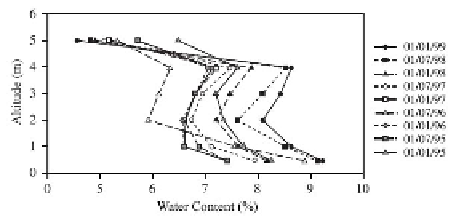Environmental Engineering Reference
In-Depth Information
In 1996, water movements in the masonry core are stable. No rising damp is
observed. In 1997 and 1998, a clear drying of the wall can be identified at 5 m
height. At other heights of the wall (between 0.5 m and 4 m) water content has
significantly increased since June 1997. These two years were not that wet, and
meteorological events cannot account for such a water gain. The origin of this
phenomenon is unexplained. Two hypotheses can be put forward: a water supply
originating from an unknown area of the building; or a new salt contamination of the
stones, which can increase the water content and lead to an equilibrium with the
relative humidity induced by the salts.
Figure 11.6.
Water content gradient as a function of a vertical profile
11.1.2.4.
Influence of weather conditions on the hydric profile observed in the wall
As the experimental façade faces west, some meteorological events may involve
water movements inside the facing wall. When strong south-westerly winds blow at
the same time as high pluviometry, measurements show a simultaneous increase in
water content at every height. Nevertheless, these phenomena are generally short,
not cumulative and do not modify the general aspect of the water content profiles
observed all throughout the year.
Figure 11.7.
Influence of pluviometry on the water content profile for a wind direction
between 200° and 300° and an intensity higher than 10 m/s


